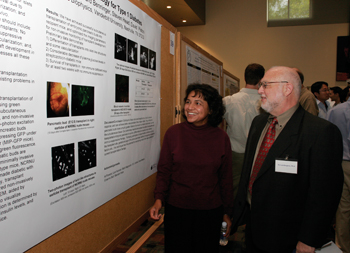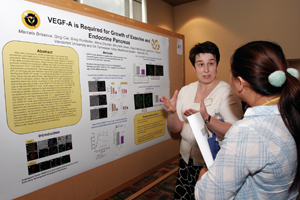
At last week’s Vanderbilt Diabetes Day, Subhadra Gunawardana discusses her poster with keynote speaker Richard Bergman, Ph.D., of the University of Southern California. (photo by Kats Barry)
Symposium highlights diabetes research efforts at Vanderbilt

Marcela Brissova, left, and Pam Fong Cheng Pan, Ph.D., review Brissova’s poster. (photo by Kats Barry)
Vanderbilt University Medical Center's commitment to diabetes research was on display last week at the annual Vanderbilt Diabetes Day, sponsored and organized by the Vanderbilt Diabetes Research and Training Center (DRTC).
At the half-day symposium, investigators discussed research inroads being made at Vanderbilt to understand and halt this growing public health threat.
“This is a very exciting time in diabetes research, probably the most exciting time since the discovery of insulin in 1921,” said Alvin Powers, M.D., director of the Vanderbilt Diabetes Center and the DRTC, in his opening remarks.
“While the overall death rate from cardiovascular disease is dropping, deaths related to diabetes are continuing to rise,” said Kevin Niswender, M.D., Ph.D., assistant professor of Medicine and Molecular Physiology & Biophysics.
Niswender discussed how obesity might account for the remaining risk of heart disease in people with diabetes. His lab has found that increasing brain levels of neuropeptide Y — a brain protein that stimulates appetite and weight gain — in rats triples blood triglyceride levels, a possible risk factor for coronary artery disease.
Although brain chemistry contributes to obesity and diabetes, geographical and socioeconomic factors are also important, according to research presented by David Schlundt, Ph.D., associate professor of Psychology and assistant professor of Medicine. Schlundt's work illustrated startling disparities in diabetes and obesity rates among the 50 states and even within different Nashville neighborhoods.
Vision loss, one of the most debilitating consequences of diabetes, happens when altered circulation to the retina causes the growth of fragile new blood vessels prone to rupture. The standard treatment for diabetic retinopathy essentially “barbeques” the peripheral retina, slowing total vision loss but sacrificing peripheral vision in the process, explained John Penn, Ph.D., professor of Ophthalmology & Visual Sciences and professor of Cell & Developmental Biology. In his talk, Penn addressed the pressing need for better models to test therapies targeting this neovascularization process.
Demonstrating how imaging techniques can be used to visualize how pancreatic islet cells “talk to each other,” David Piston, Ph.D., director of the Free Electron Laser Center and professor of Molecular Physiology & Biophysics, discussed the development of new techniques that can be used in the whole animal to study how islets function and communicate with each other.
The symposium's keynote speaker, Richard Bergman, Ph.D., chair of Physiology & Biophysics at the Keck School of Medicine at the University of Southern California, presented a new pathogenic model for the metabolic syndrome — a constellation of symptoms that increase the risk of diabetes and cardiovascular disease.
Acknowledging Vanderbilt's excellence in diabetes research, Bergman noted that “Vanderbilt continues to be a preeminent institution for diabetes research.”
In addition to the talks, investigators from departments across the Vanderbilt campus presented their latest findings at the afternoon poster session, which featured more than 40 poster presentations.
The annual event was sponsored by the Vanderbilt DRTC, which supports basic science and clinical research on the etiology, prevention, treatment and complications of diabetes. The DRTC includes more than 90 scientists and physicians in 18 departments at four Vanderbilt colleges and Meharry Medical College.













